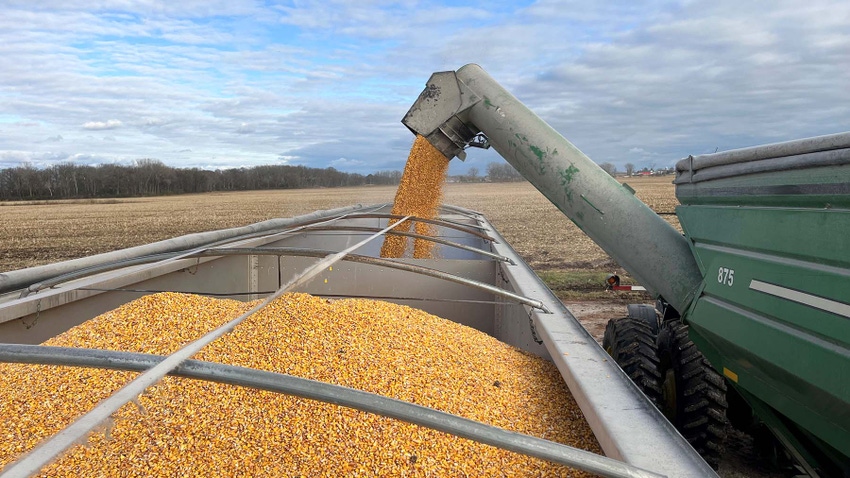
The November WASDE report delivered some surprises contrary to pre-report yield expectations. If you haven’t heard by now, let’s recap: USDA increased its corn yield estimate from 173.0 bushels per acre in October to 174.9 bpa and also added three tenths of a bushel to the soybean yield.
The former exceeded the trade average by 1.6 bpa, which skewed to the low side while the soybean yield matched the trade average.
From a supply perspective, the new corn number added 160 million bushels to availability for a not-so-small 1.49-billion-bushel increase compared to the 2022-23 crop.
The larger soybean yield raised 2023-24 supplies by 25 million bushels to 4.428 billion bushels, but this is still some 141 million LESS than the 2022-23 total. Expected ending corn stocks rose 45 million bushels from last month to 2.156 billion with virtually all of the soybean production increase adding 22 million to ending soybean stocks, which are now projected at 245 million.
The corn total represents close to an 800-million-bushel increase from the crop year just ended. The ending soybean cushion got a little larger this month but is 23 million smaller than the 2022-23 total.
So, a little negative both corn and soybeans?
The market reaction was severe, with soybeans taking the brunt of the impact. November 2023 soybeans closed 21 ¼ cents lower and December 23 Corn was off 8 cents. The average producer price of soybeans held steady at $12.90 per bushel; corn slipped a dime to $4.85.
The 2023-24 producer corn prices are now estimated to be down $1.69 per bushel versus 2022-23, more or less in-line with the larger stocks build-up. And despite the forecast for reduced soybean carry-out, farm prices are $1.30 LESS than a year ago.
Closer look at demand
The soybean report brought no changes with the export forecast continuing at 1.755 bbu and crush remaining at 2.3 billion. Corn benefited from a 50-million boost in the feed/residual estimate to 5.65 billion which more or less goes hand-in-hand with a larger crop and close to a 400,000 increase in grain-consuming animal units (mostly poultry).
A strong September ethanol/grain crush report, which resulted in corn use up 43 mbu or 10% from last year, led to 25 mbu boost to the consumption forecast. That may still be conservative.
Finally, the USDA raised the export forecast 50 million to 2.075 billion.
Higher domestic corn use
The higher corn export estimate was somewhat defendable due to:
A smaller corn crop in Mexico which at 26.5 million metric tons was reduced 900,000 from October and is now 1.6 million smaller than the 2022-23 crop
USDA sees greater corn consumption there, raising it 600,000 to 46.3 and also up a like amount versus last year
To recap: smaller crop plus larger use equals more imports. And, Mexico has so far had a voracious appetite for U.S corn. Purchases through November 2 are a record-large 390 mbu and a 60% increase from last year (sales the past two days are nearly 6 million bushels).
The Canadian corn crop is actually a bit larger this year but a 1 MMT upward revision in domestic feeding there is likely to require a similar increase in imports. Outside of those two destinations, the U.S. export picture is a little blurred: Brazil is coming off a record crop-record export year; if the Argentine crop comes in as forecast, that should add 850 mbu to its export potential from March-April forward and, Black Sea corn crops for Russia and Ukraine were boosted nearly 3 MMT this month. Their exports increased 1.6 MMT.
Bottom line? Right now the U.S. is looking at more export competition in 2023-24, making it a little difficult to buy into the USDA forecast for a 400-plus million-bushel increase in our exports.
There is concern with the lateness of Brazil soybean planting, which could push pollination of the safrinha corn crop into the hot, dry season but problems there are more likely to benefit early 24-25 U.S. exports than this year’s.
Weather woes benefit beans
First things first, the world soybean meal market is still operating from this past spring’s drought-impacted Argentina soybean crop. Weekly U.S. Soybean meal sales are occurring at a record pace and shipments are similar. Unshipped sales are up 45% year-to-year as the Argentine crush/meal exports will remain constrained through March. Brazil has seen record soybean exports this fall which in turn has been a major factor in a 200 mbu decline in U.S. export sales. However, weather extremes in both south and central Brazil heightened concerns over the upcoming soybean crop. This in turn sent China scrambling to the U.S. as a hedge for its supply chain the past couple of weeks.
Though the jury is obviously still out on this year’s South American bean crop, a “worst” case production scenario might leave it as much as 15 MMT/550 mbu larger than last year.
Soybean volatility
Stocks-to-use graphs below suggest corn is “comfortable” and may have further downside. Soybeans are in that highly volatile 5% stocks-to-use ratio area. Should foreign supplies build as forecast, there could be as much as $1.00 per bushel downside.
About the Author(s)
You May Also Like






